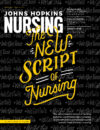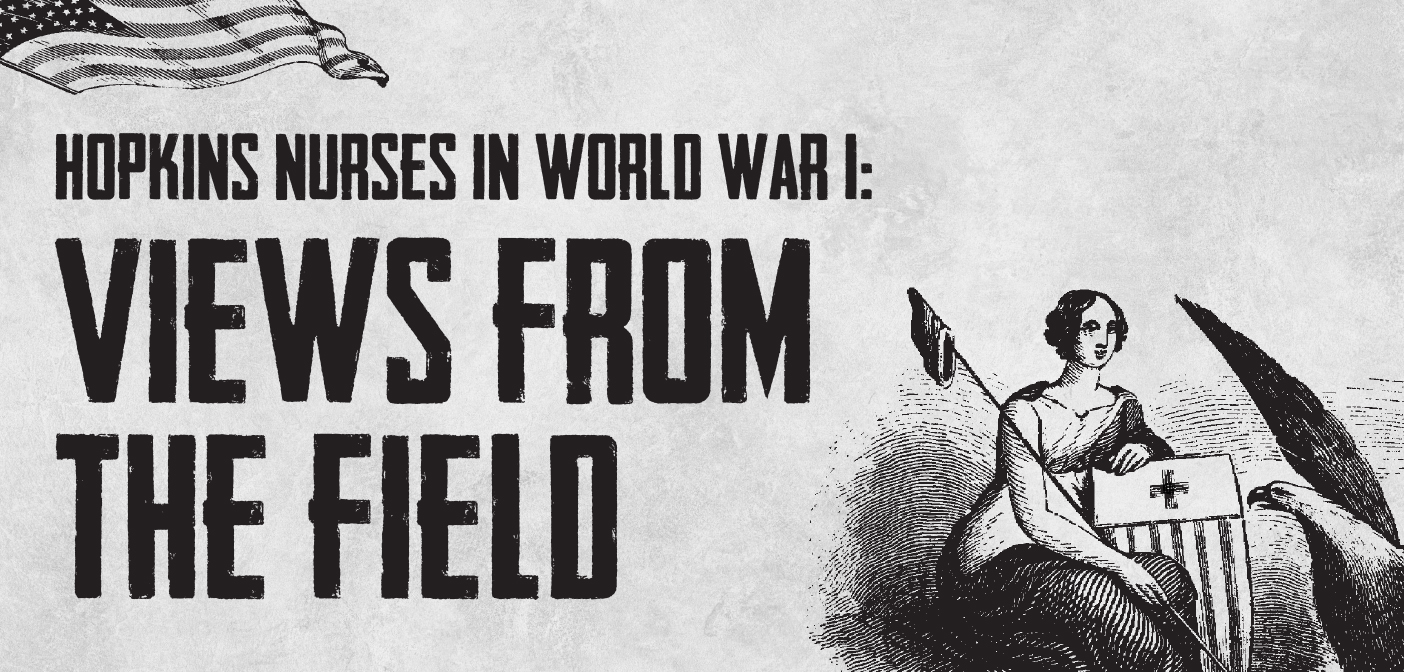By Susan E. Appling
Although the United States did not officially enter World War I until 1917, Hopkins nurses joined the American Red Cross in 1914 and were already serving throughout Europe. Others joined nursing units from Canada and France. After America entered the war, Base Hospital 18, staffed mainly with Hopkins nurses and physicians, was established in France. The correspondence from nurses serving in these units, often published in the Johns Hopkins Nurses Alumnae Magazine, poignantly describes the hardships and horrors faced by both soldiers and their caregivers.Alice Fitzgerald, 1906, the first Edith Cavell Memorial Nurse, served with a base hospital of the British Army in France in 1916. She wrote often to the Alumnae Magazine about her experiences.June 18, 1916
The rain and cold persist. I have rarely felt colder than I have here: tents are old and leaky but fortunately I am in a hut and the leaks are few and far between. I light my little oil stove every day and try to imagine I am hot!
September 30, 1916
Just as I was going to get leave, I received orders to move, and am now at 2/2 London Casualty Clearing Station, the nearest to the front, and the nearest any nurse gets.
Let me tell you that we are all but in the trenches: in fact, we are surrounded by trenches, because we are on ground evacuated by the Germans.
We are so situated that we have shell fire on three sides and the noise is simply fierce at times; so far the shells have not reached us but bombs have and the other night we were missed by about 30 yards. …
Talk of hard work! I have 2 tents holding 70 patients each and they have to lie on stretchers and pretty close, and making dressings practically on the floor, nearly breaks my back, but I get through somehow or other and am not much the worse for wear. … The most comfortable and comforting time of the day or night is when I get into my sleeping bag with a hot water bottle and tuck in for the night with my tent flap well open and try to go to sleep to the music of the bombardment.Ellen N. La Motte, 1902, an accomplished writer as well as a nurse, was so affected by her war experiences that she never again practiced. The Backwash of War, a graphic account of her war experiences was published in 1916, and in articles written for other publications and reprinted in the Alumnae Magazine she vividly recounts the terrible ordeals endured by so many soldiers and of those driven beyond the brink of sanity.When he could stand it no longer, he fired a revolver up through the roof of his mouth, but he made a mess of it. The ball tore out his left eye, and then lodged somewhere under his skull, so they bundled him into an ambulance and carried him, cursing and screaming, to the nearest field hospital. … He was a deserter, and discipline must be maintained. Since he had failed in the job, his life must be saved; he must be nursed back to health, until he was well enough to be stood up against a wall and shot. This is War.Mary Adams, 1911, describes the heavy work and many wounded in an undated letter from the February 1917 edition of the Alumnae Magazine.I had five tents each with eight of these beds but before the evening was over four more were added to each tent so that I had 12 in each. So close were the beds you could not step between. I made dressings until 12 midnight using lantern light. The next day we were up earlier than usual and I found my number of tents increasing so that I soon had 150 patients. As soon as I had finished their dressings I helped in other lines and that day it was 2 a.m. before I got to bed, barely taking time for meals.
The rush lasted for several days, sending patients to England as soon as possible and getting new ones in, so that it was one continuous convoy in and out.Finally, in letters from 1914 written by Ingebord Steen-Hansen, 1910, she describes the harrowing impact on not only the soldiers but on Belgium refugees fleeing the fighting.Stumbling, shambling women and children pushing on in a mass, in which there was an occasional cart filled with babies and old men. I thought the exodus of Belgium had stopped, but they were still coming. Such faces!
We went in among them and singled out one who was half-dragged by two others. She turned fierce eyes upon me, and I saw that the six months’ infant she clutched had its hand severed at the wrist with a crosswise cut, which was neither bandaged nor washed, but wrapped in a towel.
And then I noticed a bulging on the woman’s form, and she disclosed the reason—they had cut off her breasts—each to the depth of an inch. I saw them….
I went down near the railroad station near Dijon with my case of gauze and cotton. I knew the wounded were expected. I can see them yet. Train upon train of old, open freight cars, jerking, bumping along, with those broken bodies lying flat on the bottom with neither pillow nor cover; just as they were gathered from the field. … They were the strong English fellows of yesterday, now bullet-riddled, groaning, dirty, emaciated men. Unshaven, they looked about alike, except each had a different number sewed to his coat sleeve.These accounts, so unflinching and distressing, represent war’s realities and the stresses and traumas each nurse encountered and pushed through. With only limited equipment and drugs, the care was basic, hurried but nonetheless present for each soldier arriving from the field—a testament to each Hopkins graduate who served throughout World War I.Susan E. Appling, RN, PhD, 1973 / Sources: Warren, Mame (Ed.). (2006). Our Shared Legacy: Nursing Education at Johns Hopkins 1889-2006. Baltimore, MD: The Johns Hopkins University Press. | The Alan Mason Chesney Medical Archives of the Johns Hopkins Medical Institutions | The Johns Hopkins Nurses Alumnae Magazine

